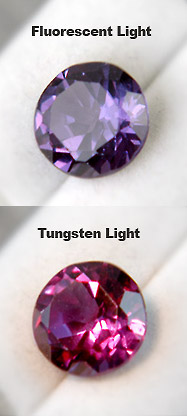| True alexandrite is a chrysoberyl and looks blue in daylight or under fluorescent light, but appears red under tungsten or candle light. It gets its color from chromium with a hint of iron.
Chrysoberyl is a beryllium aluminate akin to spinel. True alexandrite can be made using flux growing techniques or from the Czochralski process. The starting oxide mixture would contain beryllium oxide and aluminum oxide with a trace of chromium and iron. Care must always be taken when working with beryllium due to its toxicity. The final chrysoberyl would be non-toxic, but running a high temperature process using beryllium oxide requires a good deal of care.
Both synthetic spinel and synthetic corundum have been used to simulate alexandrite, and much of what we see on the market today is one or the other. The color change is not correct, the stone fails to go from green to red, but rather from a amethyst like color to garnet red.
The two stones shown here are commercial cuts and likely from the corundum simulant. They were photographed in tungsten and fluorescent light to show the color change.
|


